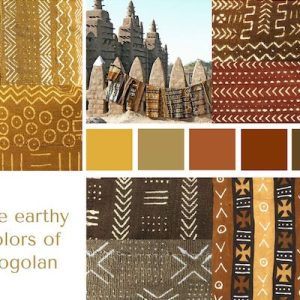Malian Bogolanfini Or Bogolan: The Need to Commercialize This Talent on a Large Scale
If the popular town of San in the prestigious coast of Mali could speak, it will be the cry not to let the glory of the Malian ‘‘mud cloth’’ die or fade away. Something must be done to modernize the production of the mud cloth by harnessing the talents involved in its production.
Bogolan refers to a clay slip with a high iron content that produces a black pigment when applied to handspun and handwoven cotton textiles. The cloth is said to be traditionally made by the Bamana who live to the east and west of Bamako, though many opine that the best of the cloth is from Beledougou area which dates to the early 12th century.
However, the town of San stands as the center of production, and the highest quality of the cloth is produced there. The mud cloth is a handmaid Malian cotton fabric dyed traditionally with fermented mud. The cloth production is done by men weaving the cloth while the women had the responsibility of dying the cloth.


The mud cloth has wide local and international use or application. It is a major or popular Malian export chief among which is to the united State either as a symbol of African American culture or as a generically ‘‘ethnic’’ decorative cloth.
Traditional Bogolanfini designs are widely used in commercial products such as coffee mugs, curtains, towels, sheets, book covers and wrapping paper, and are widely exported from Mali and used in fashion, upholstery, interiors and decoration. In decoration, mud cloth is applied to many decoration options such as scatter cushions, throws, table linen, bedspreads, and upholstery.
Origin and Cultural significance
Bogolanfini is said to be derived from three words ‘logo’ meaning mud/earth, ‘Ian’ meaning by means of and ‘fini’ meaning cloth. Malian fashion designer Chris Seydou is credited with popularizing bogolanfini in international fashion. It is virtually difficult to trace the origin due to its ancient tradition and perishable nature of the cloth, but many beautiful antique examples of this cloth can be found in museums throughout the world.
The Bogolanfini is has so cultural significance in the Malian culture, it is worn by hunters, it serves as camouflage, as ritual protection and a badge of status. Also, women after initiation to adulthood, and childbirth are wrapped with the mud cloth, as it is believed that the cloth has the power to absorb any dangerous forces released during that period.
Process Of Making Mud Cloth
Making of the mud cloth is gender specific including its spinning, weaving, and sewing. Locally grown cotton is hand spined by women while the menfolk continue the process by weaving the undyed yarn into long but narrow strips using a handheld, double heddle loom, thereafter, the strips are sewn together, selvedge to selvedge, to produce large cloths which can be used for garments for either sex. The result of this is called finimougou which is prewashed and shrunk for use in either its uncolored state or is taken to be dyed in the elaborate process that characterizes bogalanfini.


The fabric is then soaked in brown liquid which is colored by the leaves from the n’gallama tree which gives the cloth a distinctive strong yellow color base which does not appear in the finished article, but it significantly contributes to the process, acting as a fixative for the colors to come. It is the tannic acid in the tea that combines with the iron oxide in the mud to create the familiar dark brown/black background color we associate with bogolanfini.
Once the cloth is dry, the patterns are drawn on to the fabric with a pointed iron spatula, stick or quill and the negative space is covered with fermented mud until it turns grey, the design will be light (yellow) against the dark background, then mud is washed off and the process repeated and again until the desired depth of tone is achieved in the background. The remaining yellow places are the bleached to get the fabric back to its original, undyed color. These areas are painted with a substance made of ground peanuts, caustic soda, millet bran and water which turns these places a light brown. When washed out a week or later, the once yellow design will emerge bleached and pure white, a dramatic contrast to the dark ground.


Application Of Mud Cloth
The mud cloth in Mali, is worn by people of all ethnicities especially in Malian cinemas and by musicians either to express national or ethnic identity or to make a fashion statement. The cloth is popular among young people as it is made into wide range of clothes, western miniskirts and jackets as well as traditional flowing robes.
Malian fashion designer Chris Seydou is credited with popularizing bogolanfini in international fashion.
Contemporary Concern
There is a group ‘‘The Bogolan Kasobane Group’’, this group has existed since 1978 till today with the common vision or goal of innovating or promoting the idea of the making of bogolan cloth not just in Mali but to other part of the world.
But the bigger challenge is opening the process or enhancing the production processes with modern contemporary practices as growing demand for the cloth will affect the future of the traditional production of the cloth.
There is therefore the need to seek for alternative that will increase or better the production mechanism if this Malian piece of culture and art is to be preserved.
